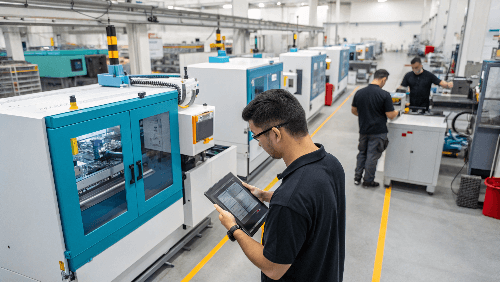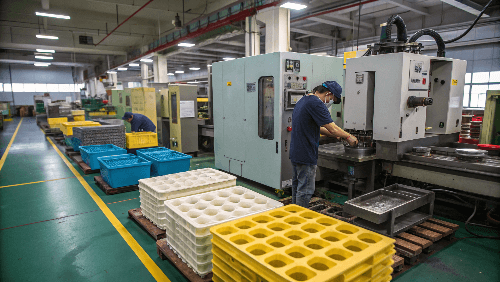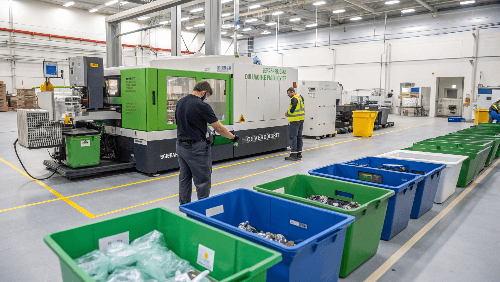Stuck troubleshooting defects or slow cycle times? Injection molding issues cost time, money, and cause major headaches for designers like Jacky trying to meet quality standards and deadlines.
Overcoming challenges involves understanding common defects (like flash, sink marks), optimizing process parameters (temperature, pressure, speed), ensuring proper mold design and maintenance, selecting the right material, and controlling environmental factors for consistency.
These problems are frustratingly common, but absolutely solvable. In my years running molding operations1 and consulting with clients, I’ve seen just about everything that can go wrong – and more importantly, how to fix it. It often boils down to a systematic approach2 rather than just randomly tweaking settings. Getting it right means better parts, less waste, and smoother production runs. Let’s break down how you can tackle these challenges head-on.
What are common defects when doing injection molding?
Ever pull a part from the mold only to find ugly marks, incomplete sections, or a warped shape? These defects halt production, lead to scrap, and frustrate everyone involved, especially when project deadlines are tight.
Common injection molding defects include sink marks, voids, flash, short shots, weld lines, burn marks, warping, and surface blemishes like flow lines. Each defect points to specific underlying issues in the material, process setup, or mold design/condition.
Recognizing these defects is the first step, but understanding their root cause is crucial for effective troubleshooting3. Think of them as symptoms of a problem that needs diagnosing. For instance, seeing flash tells a different story than seeing sink marks. As a designer, Jacky needs parts that meet both functional specs and aesthetic requirements, so eliminating these flaws4 is paramount. I always tell my team: don’t just fix the symptom, find the disease.
Common Defects and Primary Causes
| Defect | Description | Typical Primary Cause(s) |
|---|---|---|
| Sink Marks | Depressions on the surface, often over ribs/bosses | Insufficient packing pressure/time, excessive melt/mold temperature, thick wall sections |
| Voids | Internal bubbles or empty spaces | Similar to sink marks, insufficient packing, trapped gas, material shrinkage |
| Flash | Excess material squeezed out at parting line | Clamp force too low, injection pressure too high, worn/damaged mold parting line |
| Short Shot | Incomplete filling of the mold cavity | Insufficient material injected, low melt/mold temp, blocked gates, inadequate venting |
| Weld Lines | Lines where two melt fronts meet | Low melt/mold temp, slow injection speed, poor gate location |
| Burn Marks | Black or brown streaks, often at end-of-fill | Trapped air overheating (poor venting), excessive injection speed, high melt temperature |
| Warping | Distortion of the part shape after ejection | Uneven cooling, differential shrinkage, high residual stress, poor part/mold design |
| Flow Lines | Wavy patterns showing melt flow path | Low melt/mold temp, slow injection speed, inconsistent wall thickness |
Identifying the specific defect is key. Often, multiple factors contribute, requiring a systematic investigation of the process parameters, the material being used, and the condition and design of the mold itself.
How do you reduce rejection in injection molding?
Tired of seeing potentially good parts tossed into the scrap bin? High rejection rates aren’t just wasteful; they destroy profitability, delay shipments, and indicate underlying problems in your process control.
Reduce rejection by meticulously controlling process parameters (temperature, pressure, speed, time), implementing robust quality control checks, ensuring proper mold maintenance, optimizing part design for manufacturability (DFM), and training operators effectively.

Minimizing scrap has always been a top priority in my operations. Every rejected part represents wasted material, energy, and machine time. It’s a direct hit to the bottom line. Reducing rejection isn’t about a single magic bullet; it’s about discipline and attention to detail across the board. Designers like Jacky contribute significantly through DFM, making parts easier to mold correctly in the first place.
Strategies for Minimizing Rejects
- Tight Process Control:
- Establish and maintain consistent parameters for melt temperature, mold temperature, injection pressure, packing pressure, injection speed, cooling time, etc.
- Use scientific molding principles to establish optimal process windows rather than relying on guesswork. Document everything.
- Monitor process variables in real-time if possible. Modern machines offer sophisticated monitoring.
- Robust Quality Control (QC):
- Implement first-article inspection (FAI) for new setups or changes.
- Define clear quality standards and inspection criteria (visual, dimensional).
- Conduct regular in-process checks (e.g., every hour, every pallet) to catch drifts early.
- Use appropriate measurement tools (calipers, CMM, gauges).
- Preventative Mold Maintenance:
- Regularly clean mold surfaces, vents, and cooling channels.
- Inspect for wear and tear on parting lines, pins, and cavities.
- Lubricate moving components.
- Address minor issues before they cause major defects.
- Design for Manufacturability (DFM):
- Ensure uniform wall thickness, appropriate draft angles, generous radii.
- Optimize gate location and type.
- Consider material flow and potential for defects during the design phase.
- Operator Training:
- Ensure operators understand the process, quality standards, and troubleshooting basics.
- Promote consistency in part handling and inspection.
By focusing on these areas, you create a system that consistently produces good parts, drastically cutting down the rejection rate.How can I improve my injection molding process?
Is your current molding process just ‘good enough’? Settling for mediocrity means missing opportunities for better efficiency, faster cycle times, reduced costs, and higher overall part quality, potentially letting competitors get ahead.
Improve the process through systematic optimization (like Design of Experiments – DOE), investing in modern machinery (e.g., all-electric), automating repetitive tasks, using process monitoring software, and fostering continuous training and improvement culture.

Continuous improvement is the name of the game in manufacturing. Just because a process works doesn’t mean it can’t be better. I’ve always pushed my teams and advised clients to look for ways to shave seconds off cycle times5, reduce material usage, or improve consistency. These incremental gains add up significantly over large production runs. It requires moving beyond simple troubleshooting to proactive optimization6.
Avenues for Process Improvement
- Systematic Optimization:
- Instead of random adjustments, use structured methods like Design of Experiments (DOE).
- DOE helps identify which parameters have the biggest impact and finds the optimal combination for specific goals (e.g., fastest cycle, best dimension, lowest defects).
- Focus on key variables: melt/mold temperatures, injection/packing pressures and speeds, cooling time.
- Modern Machinery:
- All-electric machines offer superior precision, repeatability, energy efficiency, and often faster cycle potential compared to older hydraulic machines.
- Servo-hydraulic machines provide a balance of performance and cost.
- Upgrading auxiliary equipment (dryers, chillers, robots) also contributes.
- Automation:
- Robots for part removal ensure consistency, reduce cycle time variability, and prevent damage.
- Automated inspection systems (vision systems) can catch defects reliably.
- Downstream automation (degating, assembly, packing) improves overall workflow efficiency.
- Process Monitoring Systems:
- Software that tracks key parameters (pressures, temperatures, times) in real-time for every cycle.
- Allows for Statistical Process Control (SPC) to detect process drifts before they cause rejects.
- Provides valuable data for troubleshooting and optimization.
- Continuous Improvement Culture:
- Encourage operators and technicians to identify problems and suggest improvements (e.g., Kaizen).
- Provide ongoing training on new techniques, materials, and equipment.
- Regularly review performance metrics (cycle time, scrap rate, uptime) to identify areas for focus.
Improving the process is an ongoing effort, not a one-time fix. It requires investment in technology and people, but the returns in efficiency, quality, and cost savings are usually well worth it.What other factors can be expected to contribute to the part quality during injection molding?
Focusing solely on machine settings and the mold itself? Overlooking crucial ‘surrounding’ factors like material handling or the workshop environment can lead to unexpected quality issues that derail production schedules and frustrate efforts.
Beyond core process parameters and mold condition, critical factors influencing part quality include raw material consistency and preparation (especially drying), mold temperature control stability, ambient factory conditions, and post-molding handling procedures.

I’ve seen perfectly good molds and well-set processes produce bad parts simply because someone overlooked how the material was handled or how consistently the mold temperature was maintained. Quality is a chain, and every link matters. For designers like Jacky, understanding these factors helps in specifying materials correctly and anticipating potential issues that might arise during production, beyond just the part geometry.
Key Supporting Factors for Quality
- Material Quality & Preparation:
- Consistency: Variations between material batches (MFI, additives, moisture) can affect processing and part properties. Use reputable suppliers and check certifications.
- Drying: Crucial for hygroscopic materials (PET, Nylon, PC, ABS etc.). Insufficient drying causes splay, brittleness, and dimensional instability. Use appropriate drying equipment (desiccant dryers) and verify moisture content.
- Contamination: Keep materials free from dust, dirt, or mixing with other plastic types. Store properly.
- Mold Temperature Control (TCU):
- Stability: Consistent temperature across the mold surface is vital for uniform cooling, controlling shrinkage, preventing warpage, and achieving desired surface finish.
- Accuracy: Ensure Temperature Control Units (TCUs) are functioning correctly and providing the set temperature reliably.
- Flow: Check that cooling channels are clear and providing adequate flow for heat removal.
- Ambient Environment:
- Temperature & Humidity: Extreme fluctuations in the factory environment can affect material behavior (especially moisture absorption before drying) and machine performance (hydraulics, electronics). Climate control can be beneficial for sensitive processes.
- Post-Molding Handling:
- Cooling: How parts are removed and cooled immediately after ejection can influence final dimensions and stress levels (e.g., dropping hot parts into water vs. air cooling on a conveyor).
- Degating: Manual vs. automatic degating can affect cosmetic appearance and potentially induce stress.
- Fixturing: Some parts may require cooling fixtures to prevent warping as they fully solidify.
- Secondary Operations: Annealing or conditioning steps can be necessary for some materials/applications to relieve stress or stabilize dimensions.
Paying attention to these often-overlooked factors provides a more robust and reliable injection molding operation, leading to consistently higher quality parts.How can I make injection moulding more sustainable?
Feeling the pressure to reduce your manufacturing environmental impact? Simply ignoring sustainability risks future regulatory issues, potentially harms your brand image, and misses out on significant cost-saving opportunities tied to efficiency.
Make molding more sustainable by prioritizing energy-efficient machines (all-electric), optimizing processes to cut cycle times and minimize scrap, utilizing recycled or bio-based plastics where feasible, employing hot runner systems, and managing energy and water usage carefully.

Sustainability isn’t just a buzzword anymore; it’s becoming a core business requirement. Clients, consumers, and regulators are all increasingly demanding greener manufacturing practices. The good news is, many sustainable practices in injection molding7 also lead to lower operating costs. Reducing energy consumption, minimizing material waste8 – these actions benefit both the planet and the profit margin. It’s something I actively discuss with clients like Jacky when planning new projects.
Pathways to Greener Molding
- Energy Efficiency:
- Machine Choice: All-electric machines use significantly less energy (often 50-70% less) than hydraulic machines because they only consume power when needed for movement. Servo-hydraulic offers improvement over standard hydraulic.
- Process Optimization: Faster cycle times mean less energy consumed per part produced.
- Insulation: Insulating the heater bands on the barrel reduces heat loss and energy consumption.
- Auxiliaries: Use energy-efficient dryers, chillers, and grinders.
- Material Selection & Usage:
- Recycled Content: Incorporate Post-Consumer Recycled (PCR) or Post-Industrial Recycled (PIR) materials when application requirements allow. Requires careful testing and process adjustment (e.g., drying rPET properly).
- Bio-plastics: Explore bio-based or biodegradable plastics for suitable applications, understanding their unique processing needs and end-of-life characteristics.
- Material Reduction: Design parts with optimal wall thickness (thin-walling where possible) and core out non-critical areas to use less material.
- Waste Reduction:
- Hot Runners: Eliminate runner scrap entirely, saving significant material, especially with expensive engineering resins or long production runs.
- Regrinding: Efficiently collect, grind, and reuse acceptable levels of scrap (runners from cold runner molds, clean rejected parts) where quality permits.
- Defect Prevention: Robust process control directly minimizes scrap parts (see section on reducing rejection).
- Resource Management:
- Water: Use closed-loop cooling systems for mold temperature control to minimize water consumption. Maintain systems to prevent leaks.
- Logistics: Optimize shipping and packaging to reduce transportation footprint.
Adopting these sustainable practices demonstrates responsibility and often leads to a more efficient, cost-effective, and competitive injection molding operation.Conclusion
Overcoming injection molding challenges requires a systematic approach. By understanding defects, optimizing processes, maintaining equipment, handling materials correctly, and embracing sustainable practices, you can achieve higher quality parts, reduce waste, and improve overall efficiency.
-
Explore this link to discover effective strategies and insights that can enhance your molding operations and reduce common issues. ↩
-
Understanding the benefits of a systematic approach can lead to more efficient manufacturing and better problem-solving techniques. ↩
-
Learning best practices for effective troubleshooting can significantly improve your problem-solving skills. Check out this resource for valuable insights. ↩
-
Discover strategies for eliminating flaws in design and manufacturing to ensure high-quality products. This resource offers practical solutions. ↩
-
Learning about cycle time reduction techniques can lead to significant efficiency gains in your production operations. ↩
-
Understanding proactive optimization can help you shift from reactive to strategic improvements in your manufacturing processes. ↩
-
Explore this link to understand how sustainable practices can enhance efficiency and reduce costs in injection molding. ↩
-
Learn about innovative methods to minimize material waste, which can improve sustainability and profitability in manufacturing processes. ↩
